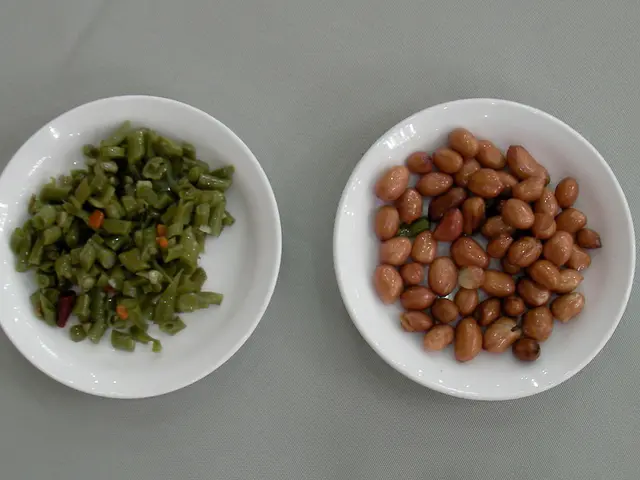Delicious Smoothie Recipes for Children: 7 Easy-to-Make, Kid-Approved Smoothie Options
Smoothies are not just for adults anymore. These blended delights can be a fun and delicious way to increase children's intake of fruits, vegetables, and essential nutrients.
A mother of two, Sarah, shares her success story, "My 5-year-old refused to eat anything green until I started making 'monster smoothies.' Now he drinks spinach every morning without realizing it's the same vegetable he rejects at dinner!"
Preparing smoothies for kids doesn't have to be a daunting task. Here are some effective tips to create nutritious and appealing smoothies:
- Use naturally sweet, frozen fruits such as banana, mango, pineapple, cherries, strawberries, and berries. Frozen fruits help create a thick, cold texture that kids enjoy while adding natural sweetness without extra sugar.
- Incorporate mild-tasting greens like spinach or kale in small amounts. These can add vitamins and fiber without overpowering the flavor, especially if paired with sweet fruits like banana or berries to mask the green taste.
- Add protein and healthy fats by including ingredients like almond butter, yogurt, or chia seeds. This helps keep the smoothie filling and nutritionally balanced.
- Use kid-friendly liquids such as almond milk, dairy milk, or sweet fruit juices (pineapple, orange, or apple juice) to enhance flavor and creaminess without adding artificial sweeteners.
- Keep recipes simple and colorful to attract children's interest visually — vibrant color from berries or green leafy veggies can make smoothies more appealing.
- Involve kids in preparation by letting them help add ingredients or choose toppings to increase their enthusiasm for drinking smoothies.
- Avoid added sugars or artificial sweeteners; rely on the natural sweetness of fruit and the creaminess of banana or yogurt to satisfy kids’ taste buds.
- Adjust texture and flavor by adding more or less liquid to achieve a smooth, creamy consistency that kids prefer.
- To reduce the sugar content in fruit smoothies, use vegetables as part of the base, choose lower-sugar fruits, add protein and healthy fats, use unsweetened milk alternatives and plain yogurt, avoid added sweeteners like honey or maple syrup, and start with less sweet smoothies from the beginning so kids don't develop a preference for overly sweet versions.
- When introducing new add-ins, start with small amounts (1 teaspoon) and gradually increase to prevent overwhelming changes in taste or texture that might lead to rejection.
Smoothies can be a healthy part of a child's daily diet when made with whole food ingredients and limited added sugars. For example, Greek yogurt, chia seeds, flaxseed, peanut butter, rolled oats, and avocado are nutritious add-ins for smoothies.
To make smoothies more convenient, consider preparing Make-Ahead Smoothie Packs by placing pre-measured fruits, vegetables, and add-ins (except liquids) in individual freezer bags. When ready to make, simply dump the contents into a blender, add liquid, and blend!
Portable Smoothie Solutions can be used by freezing smoothies overnight in insulated containers or reusable pouches to send in lunchboxes. Smoothies are best consumed within 24 hours, even when refrigerated. Separation is normal-just shake or stir before drinking. If frozen, smoothies maintain quality for up to 3 months.
Smoothie Popsicles can be made by pouring leftover smoothie into popsicle molds for a healthy frozen treat.
Remember, the key is to make the smoothie-making process enjoyable for kids. Let them help in the kitchen, choose their favourite ingredients, and watch as their favourite vegetables transform into delicious, nutritious smoothies!
References:
[1] Nutrition.gov. (2021). Kids Eat Right: Smoothies. [online] Available at: https://www.nutrition.gov/health-and-fitness/kids-eat-right/kids-eat-right-smoothies
[2] Academy of Nutrition and Dietetics. (2021). Kids Eat Right: Smoothies. [online] Available at: https://www.eatright.org/health/nutrition/children-and-teens/kids-eat-right-smoothies
[3] Healthline. (2021). How to Make Healthy Smoothies for Kids. [online] Available at: https://www.healthline.com/nutrition/how-to-make-healthy-smoothies-for-kids
[4] American Heart Association. (2021). Kids Eat Right: Smoothies. [online] Available at: https://www.heart.org/en/healthy-living/healthy-eating/eat-smart/kids-eat-right/kids-eat-right-smoothies
- Incorporating 'wisdom' from experts, smoothies can be an effective way to introduce more 'health-and-wellness' elements, such as fruits, vegetables, and essential nutrients, into a child's 'lifestyle'.
- A tactic used by Sarah, the mother of two, to boost her children's 'nutrition' intake is creating 'fitness-and-exercise' themed smoothies, named 'monster smoothies', which include hidden greens like spinach.
- To make the 'food-and-drink' more appealing to kids, parents can consider creating smoothies with a 'science' behind them, such as using kid-friendly liquids, adding protein and healthy fats, and keeping recipes simple and colorful.
- In the realm of 'parenting', involving kids in the preparation process, like choosing their favorite ingredients or helping add them to the blender, can increase their enthusiasm for healthy 'lifestyle' choices.







